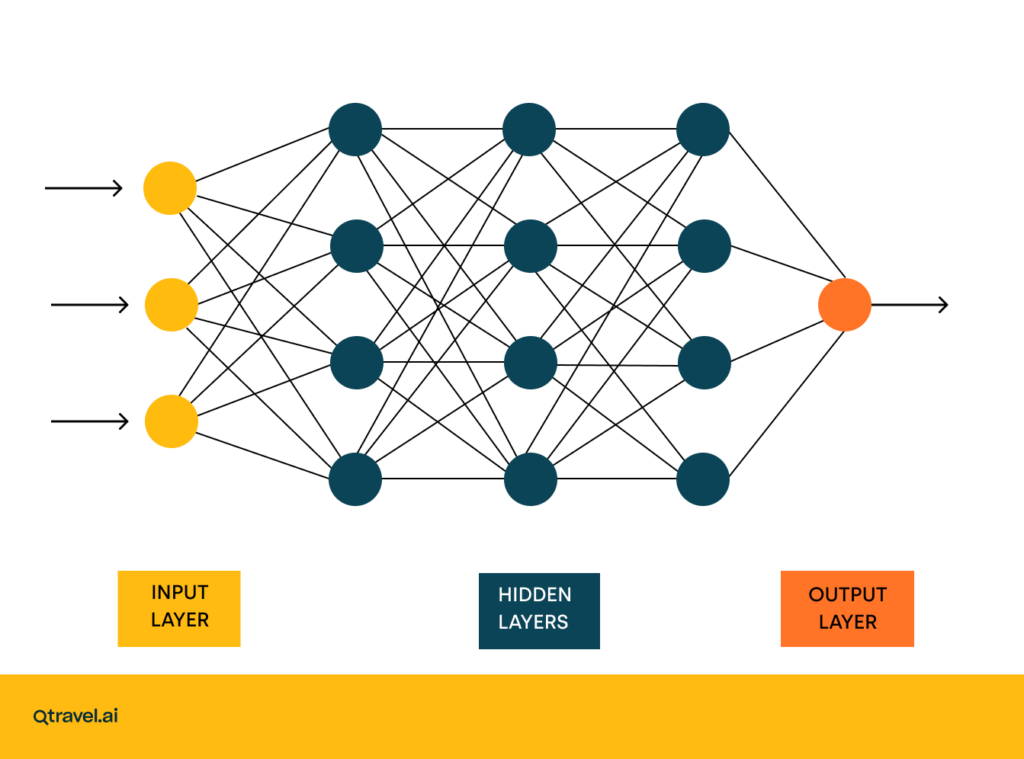Neural networks are another popular concept we have decided to address in our articles on artificial intelligence terminology. In this post, you will find a comprehensive definition and learn about their history, how they function, and their various applications.We invite you to read on!
Let’s start with the definition.
Neural networks (NN), or artificial neural networks (ANN), are loosely connected models with flexible structures and large parameter space.
Thanks to the inspiration from the biological mechanisms of brain function, neural networks can recognize patterns in data and solve complex tasks related to language understanding and computer vision, among other things.
Therefore, neural networks are composed of layers, of which we can distinguish three types:
- Input layer: This is where the data is directed, which the network will process.
- Hidden layers:These are located between the input and output layers. They are called “hidden” because their inputs and outputs are not directly visible. In these layers, the model gains the ability to recognize patterns in the data, updating its parameters (weights) during training based on the input data.
- Output layer: This layer returns the final result of the network’s operation. It could be, for example, recognized word categories in text or objects detected in an image.

A key aspect of neural networks is that during training, they learn which aspects of the input data affect the final processing result without manually extracting features from the data (which was a laborious and uncertain process before the era of neural networks). As new data is fed to the networks, they get better at feature extraction, thus improving their task performance. Over time, this makes them powerful tools with many applications.
How do neural networks work?
As mentioned above, neural networks are inspired by their biological counterpart – the human brain They consist of many closely interrelated nodes – processing units responsible for a different aspect. Each processing node contains its database, including all the previous rules it has been trained on.
Creating a neural network starts with the first nodes receiving raw input data. Then, each node receives the results from the previous one. It continues until the last node processes the information and generates the output data, the final result.
For this article, let’s imagine that each node is a robot that analyzes certain information. Each robot that makes up the neural network receives information from the outside (input data) and focuses on a specific aspect of that information. For example, one might analyze shapes, and the second one – colors.
When a robot receives information, it weighs it according to its own “importance” scale, and some things may be more important to it than others.
Next, it checks if the sum of this information exceeds a certain threshold. If so, the robot activates and sends a signal to the next robot in its network. If not, the robot does not activate or send a signal.
During this process, all information passes through the network, from one robot to the next, until we finally get a result – for example, about what is in a given image.
It’s worth adding that the mentioned weights and thresholds are initially set randomly, which means that the network initially operates with low effectiveness. However, by processing an increasing amount of data, the network adjusts its parameters, constantly increasing its effectiveness and precision.
The History of Neural Networks
The history of neural networks dates back to 1943 when mathematicians Warren McCulloch and Walter Pitts built a system of circuits that ran simple algorithms, functioning similarly to the human brain.
Their further development didn’t pick up speed again until around 2010, over 60 years later. This resurgence was linked to the rise of the Big Data trend, where companies began amassing substantial volumes of data. This trend facilitated the collection of the necessary data and computing power to operate complex artificial neural networks.
One of the critical events in the history of neural networks was the victory in the ImageNet challenge by Alex Krizhevsky, Ilya Sutskever, and Geoffrey E. Hinton, who created AlexNet – a unique deep convolutional neural network. Their revolutionary architecture could classify 1.3 million high-resolution images, achieving an error rate of 15.3%.
This achievement sparked an explosion in deep learning research, and technology companies began to massively invest in classification technologies using AlexNet and create other models for developing realistic problem solutions, such as image detection, image classification, and much more.
Examples of Neural Networks Applications
We’re already familiar with the theory. Now let’s move on to practice. Neural networks have virtually limitless potential, and listing all their applications is impossible. Below are a few popular examples of their use in various sectors.
Tourism
Neural networks learn from historical data, identifying specific patterns and relationships – for example, during which months there is greater interest in selected travel destinations. Then, they can, among other things, predict demand for specific travel offers, allowing travel companies to plan their activities more effectively.
Read also: Artificial Intelligence in Tourism: Key Benefits and Use Case Examples
Search Engines
Neural networks are also employed in search engines that analyze user queries and deliver relevant results. By learning from billions of queries, they can understand the context and nuances of language, providing answers to even the most complex queries.
Social Media
Neural networks analyze large amounts of data generated by users, which allows for a deeper understanding of their behaviors. This information can be utilized in various ways, including creating personalized advertisements.
Aircraft
Neural networks can be used for error diagnostics during aircraft production, crew training, and even in autopilot systems.
Meteorology
Neural networks can analyze data such as air humidity, temperature, solar radiation, and wind speed to provide the most accurate weather forecasts.
Defense
Neural networks are used for object location, analyzing armed attacks, controlling autonomous drones, and managing air and sea patrols.
Healthcare
Neural networks can accurately analyze images, such as X-rays or computer tomographies. Moreover, they’re also used in research for discovering new medications.
Neural Networks: Key Concepts and Terminology
Node / Neuron: The basic component of a neural network that receives one or more inputs, processes them and then returns an output.
Layer A group of neurons working together during the same phase of the processing procedure.
Supervised Learning A type of machine learning in which the neural network is trained with input data and the corresponding output data, which serves as a “teacher.”
Unsupervised Learning: A type of machine learning where the neural network is trained with input data but without any output data as a guide. The network must find the structure or patterns in the data itself.
Reinforcement Learning: A type of machine learning in which the model is trained through a system of rewards and penalties, enabling it to learn from its own decisions.
Convolutional Neural Networks (CNN): A type of neural network that utilizes a convolution mechanism to detect and process patterns, such as in images. Instead of analyzing the entire image simultaneously, CNNs review small portions using filters, learning to recognize various features, such as shapes or colors. With each additional layer, the model extracts features from the image at an increasingly higher level of abstraction. Initially, these features identify simple shapes, which later become features that specify the presence of, for instance, a face or a specific hand gesture. Apart from image recognition, this is also useful in other tasks, such as Natural Language Processing (NLP) or Optical Character Recognition (OCR).
Deconvolutional Neural Networks: Networks that function similarly to convolutional networks but in reverse. They use information that the convolutional network might have discarded during analysis to uncover hidden features or signals. They are especially useful in image analysis, helping the computer to “decode” their details.
Recurrent Neural Networks (RNN): Neural networks that can remember information from previous calculations. It is especially useful when past information impacts current results. They are typically used for understanding and generating speech and predicting trends.
Feed-forward Neural Networks: A type of neural network that processes data step by step, transmitting information from input to output. They help computers recognize images, understand language, or analyze complex patterns in data.
Modular Neural Networks: Complex neural networks composed of many smaller, independent networks, each focusing on a specific part of the problem. It is akin to a team of specialists, each focusing on their expertise, enabling faster and more efficient problem-solving.
Generative Adversarial Networks (GAN):An advanced type of neural network that consists of two parts: one generates new data, and the other attempts to distinguish these new data from the real ones. They are used to create realistic simulations, such as generating images that look like actual photos.
Deep Neural Network (DNN): A type of neural network with multiple layers (“deep”). DNNs can recognize complex patterns in data by processing information through multiple layers. They are used in various fields, such as image or speech recognition, machine translation, or market trend prediction.
Conclusion
As you can see, neural networks are a complex concept, particularly for non-technical individuals. However, we hope we’ve been able to explain the basics of their operation and introduce you to the vast possibilities they offer.
If you represent the tourism industry and wonder how they can be applied to your business, contact us. We’d be happy to share our knowledge and extensive experience in the field of artificial intelligence.
